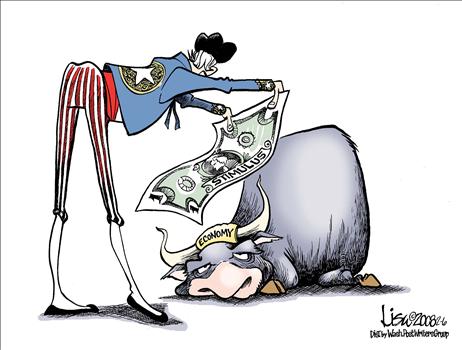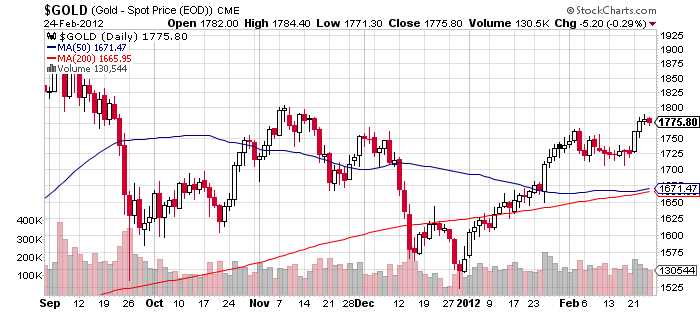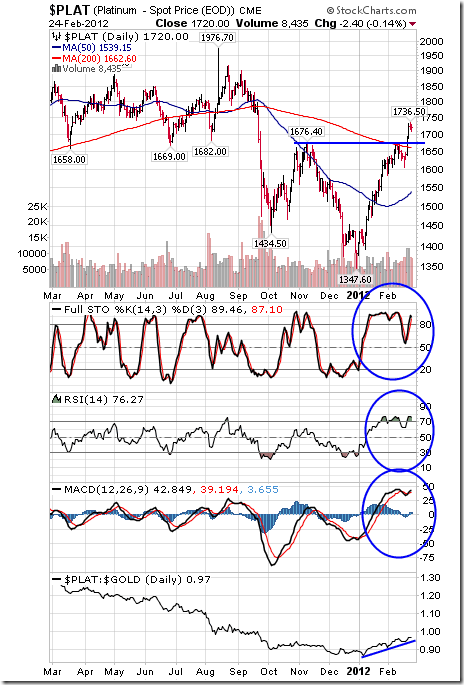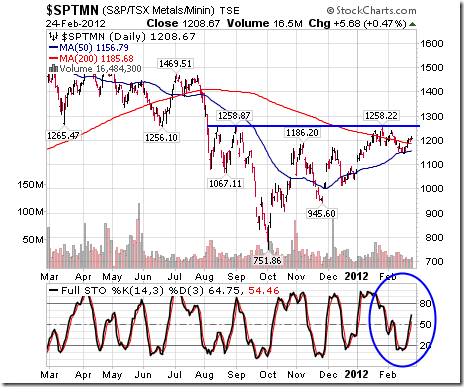“Every segment of the gold stock market is very cheap today.” Opportunities abound across the spectrum of precious metal equities, which remain undervalued as bullion prices continue their upward trends. That’s the word according to Charles Oliver and Jamie Horvat, both senior portfolio managers at Sprott Asset Management. In this exclusive interview with The Gold Report, Oliver and Horvat express cautious optimism about the prospects for gold stocks in 2012.
COMPANIES MENTIONED: BARRICK GOLD CORP. – BELO SUN MINING CORP. – CANACO RESOURCES – COEUR D’ALENE MINES CORP. – COLOSSUS MINERALS INC. – CONTINENTAL GOLD LTD. – GOLDCORP INC.– HECLA MINING CO. – LAKE SHORE GOLD CORP. – PAN AMERICAN SILVER CORP. – PERSEUS MINING LTD. –PREMIER GOLD MINES LTD. – SCORPIO GOLD CORP. – TAHOE RESOURCES INC.
Gold and Silver Stocks Poised to Recover in 2012: Charles Oliver and Jamie Horvat
The Gold Report: When we talked in the wake of the debt ceiling crisis last fall, Charles, you expected volatility to be good for gold and forecast a continuing long-term bull market for precious metals. These days, the scary stories pertain to the European Union (EU). Will negative headlines continue to play a role in the price of gold and silver?
Charles Oliver: Absolutely. The headlines about the European Central Bank (ECB) infusion of billions of euros into the banking system has been very good for the price of gold. Since the ECB announced it would be issuing €489 billion in December, gold has had a nice little rally off its lows. I expect in the next couple of weeks a further issuance of money will be quite supportive for gold.
Europe is still a mess. Greece seems to be heading to bankruptcy in slow motion. That problem has been going on for two years and we could find these issues still persisting a year from now. Ultimately, central banks around the world will continue to print and debase their currencies, which will be very good for the gold price.
TGR: Jamie, do you agree with that? Or might Greece strike a deal to pay off its debt, turning the price of gold down?
Jamie Horvat: I think the deal is based on the fact that the only tool governments have at their disposal is the continued monetization of debt and the continual printing of money, which is always good for gold. On the other hand, if Greece does not get the sought-after debt relief and restructuring or, if it is kicked out of the EU, it could result in the unwinding of the European banking system and could have larger implications globally. If that happens, we’ll see a short-term hiccup in the gold price as it is used as a source of liquidity and investors sell their future in an attempt to live and fight today. That may be the tail-risk event as we continue to see additional quantitative easing (QE) programs all over the world. From Japan to the UK, more than $1 trillion could be spent in the next few months to provide ongoing liquidity in Europe. That is why the longer term outlook for gold is still positive.
TGR: In a November television interview, Charles, you expressed concern about China’s growth. Has that changed? And what are the implications for precious metals?
CO: The China story affects the industrial metals more than the precious metals, but I’m still concerned that we see weakness in China. The volume of loans being done now and the contraction we’re seeing there both signal that weakness. A number of other economic statistics indicate that China is clearly slowing down; the only question is how big a slowdown it is. Ultimately I think it will impact the base and bulk metals more than gold and silver—copper, iron ore, steel, those types of things.
TGR: Your $644.5 million Sprott Gold and Precious Minerals Fund ended 2011 with a tough quarter, off 10.6% compared to an 8.7% loss on the benchmark S&P. Your quarterly report cited tax-loss selling as one of the reasons for thinly trading stocks performing poorly. Have you adjusted your portfolio since then?
CO: The portfolio is continuously being upgraded. We made a number of changes during the last quarter. We did some of our own tax-loss selling in the portfolio. When I sold some of those stocks, I tried to redeploy the proceeds into some of the other names that I wanted to own that were also experiencing tax-loss selling. A lot of companies in the junior space were down 70%. It wasn’t through any fault of their own; it was just because the market had no interest in small companies because it was risk averse last year.
TGR: Were the other names you were buying into mainly juniors?
CO: Yes, there were a fair number of juniors, but every segment of the gold stock market is very cheap today. I can find great valuations in small-, mid- and large-cap stocks. All of them are extremely cheap. That’s not always the case. You might think all segments would move together, but in reality one segment often does much better than the others during a particular year.
TGR: It appears as if about 30% of the fund is dedicated to the small-cap issuers, which have a little bit higher risk profile then the large caps. Do you see those small caps as the way to drive growth in the portfolio?
CO: If you look over the last decade, a lot of the alpha that’s being generated in the gold fund has been through small- and mid-cap names. That’s across the board. Whether in the gold space, the oil space or any other type of stock, generally speaking, small-cap stocks have better growth and long-term growth returns.
TGR: What are some of the juniors you picked up as you were redeploying at the end of the year?
CO: I can mention a few names from my most recent year-end report for investors. Canaco Resources Inc. (CAN:TSX.V) is a small cap with a project in Tanzania. It did a financing at around $5.40/share back in March 2011. It’s a good stock, but through tax-loss selling and an aversion to small-cap stocks, it has traded down to below $1.50/share. What a great opportunity.
I looked at Canaco several years ago. It was really interesting, but it was a little on the early-stage side and it got away from me. I’m not one who likes to chase stocks; I don’t run after them. And then last year, Canaco had a lot of cash on its balance sheet and suddenly came under severe selling pressure. I thought, “Great, I’m getting a second opportunity to buy something at a much better price.” Additionally, I expect its property in Tanzania will one day be a mine.
TGR: How many years away is that?
CO: Probably 5 to 10 years. The lifecycle in the mining industry is usually at least that long from a grassroots discovery through permitting, construction and ultimately getting into production. In the small-cap space, I’m always on the lookout for companies that I believe will have a mine at some point in the future. Canaco is a good example of that.
TGR: Any other examples of companies that could be big movers in 2012?
CO: Another company, Lake Shore Gold Corp. (LSG:TSX; LSG: NYSE) was down 70% in the last year. I actually owned it a couple of years ago, and thought it got expensive. It was trading north of $4.50/share not too long ago, and went down to almost $1/share. The company had a few hiccups in terms of its mine plan, but the stock has been overdone. I sold it up much higher and took this as an opportunity to get involved with it again.
TGR: How high could it go?
CO: There is no reason Lake Shore Gold can’t get back to the highs it made last year if it executes on its strategy. These things usually just take a bit of time.
TGR: Eric Sprott is probably one of the leading silver bulls in the world. In your view, what’s the ideal balance between gold and silver equities and bullion in an investors’ portfolio?
CO: I believe it makes a lot of sense to have a combination of both stocks and bullion. It really depends on the individuals in consultation with their financial advisors to get the appropriate allocation. Bullion is an asset that helps preserve capital. You’re not there to make a killing. You’re there to protect capital, especially in the context of the currency debasement that is going on. Gold stocks are more of an asset used to capture capital gains during the bull market we are in. Many studies have suggested that 5–10% on a long-term basis is a good allocation to precious metals. I’ve heard some numbers much higher at the Sprott organization, but again, I think it ultimately depends on an individual’s goals, propensity for risk and capital preservation requirements due to age and circumstances.
TGR: What are some of your favorite names among silver equities?
CO: I like the large caps. Pan American Silver Corp. (PAA:TSX; PAAS:NASDAQ), which is trading at about 9–10 times its price/earnings (PE) ratio, has potential to double production over the next five years as it builds its Navidad mine in Argentina. Pan American is fully funded to get that growth.
Coeur d’Alene Mines Corp. (CDM:TSX; CDE:NYSE) is another one trading at about 9–10 times its PE ratio. It has doubled production over the last four to five years. This company actually has done a great job; it’s one of the few over the last couple of years that have managed to do a pretty darn good job of keeping cash costs very low. If you look at almost all of the large-cap silver names, you’ll find most of them trading either at high single-digits to low double-digit PE ratios. They are extremely cheap.
TGR: What are some catalysts that could take Coeur d’Alene to the next level?
CO: I think it’s just a matter of time and execution. Ultimately these companies will make good earnings and cash flows at the current price. One of the things we’ve seen in the gold sector, and are certain to see a bit in the silver sector, is that a lot of these companies are starting to initiate dividends. Last yearHecla Mining Co. (HL:NYSE) announced a plan to pay a dividend linked to the silver price. In a recent presentation I attended, Coeur d’Alene suggested that it might start looking at paying a dividend sometime next year.
TGR: Could that have a big impact on the share price?
CO: We will have to wait and see, but I think investors look for good companies that pay nice yields.
TGR: What are some other promising silver names?
JH: On the development and exploration side, Tahoe Resources Inc. (THO:TSX) has great potential as it moves toward production on its flagship Escobal project in Guatemala. We like what we see in Tahoe’s exploration there—the whole development story. It may have a world-class asset with the resource and reserves it currently has on hand—plus significant exploration upside as well.
Scorpio Gold Corp. (SGN:TSX.V) is a junior that has come off the bottom. Scorpio has been viewed in the past primarily as a base metals company and a zinc producer, but most of its upside in terms of both exploration and production now comes from silver exposure. I continue to like Scorpio.
TGR: With so many companies in the small- and large-cap area beaten down, how do you determine which ones will deliver?
JH: As Charles mentioned, valuations are pretty depressed. Looking at the large caps broadly, you have to distinguish between those that are executing projects and those that aren’t. Among the companies reporting recently, Agnico-Eagle Mines Ltd. (AEM:TSX/NYSE) and Kinross Gold Corp. (K:TSX; KGC:NYSE) are two examples of companies that unfortunately lost some ground. Agnico enjoyed a premium thanks to its growth profile, but lost that premium because it didn’t execute on that growth profile. Kinross, too, has declined due to the lack of execution.
On the other hand, Barrick Gold Corp. (ABX:TSX; ABX:NYSE) was in line and Goldcorp Inc. (G:TSX; GG:NYSE) was above estimates. Both Barrick and Goldcorp have growth projected into 2016, but they’re trading at depressed multiples to the group. Goldcorp has 60% growth ahead of it.
Investors who have been going to the price participation of exchange-traded funds or gold bullion will slowly start coming back to the market if some of these companies continue to capture that cash-flow margin and continue to increase dividend payments. They will be attractive to investors if they show a willingness to return capital to shareholders. In terms of the market in general, investors seem to want to be paid to participate in the market, so they are looking for companies with yield.
TGR: What names fit the criteria you mentioned for companies that have upside ahead of them?
JH: Based on projects in development and assuming they continue to execute and move the projects forward, some of the names I like are Belo Sun Mining Corp. (BSX:TSX.V), Colossus Minerals Inc. (CSI:TSX), Continental Gold Ltd. (CNL:TSX), Premier Gold Mines Ltd. (PG:TSX) and Perseus Mining Ltd. (PRU:TSX; PRU:ASX). These are all things I continue to monitor and continue to like.
TGR: Belo Sun is sitting at about $1/share now. What do you like about it?
JH: Belo Sun’s 100% owned Volta Grande project in Brazil is located in an area with good infrastructure and the government is building the world’s third-largest hydro-damming facility just to the north. It’s a really good project with recent—and continuing—exploration success, in a good jurisdiction with good economics around the project. I believe that has the potential to be a mine one day.
Belo Sun also has added significantly to the resource and continues to move the project forward. I’ll continue to like those types of projects as long as they continue to execute. So far, though Belo Sun hasn’t been rewarded for its success. Small caps were down 38% on average in 2011.
TGR: Do you have favorite jurisdictions?
CO: When you look at the jurisdictions in our portfolio, about 80% of the companies are domiciled in Canada while 80% of the operations are international. We do have some big concerns about politics and country risk. A couple of years ago, when a lot was going on in Africa, we decided to cut back on some of our African names. Not eliminate them, but reduce the weighting and redeploy those funds into operations in North and South America. Now we are unfortunately experiencing some issues in South America, such as what is going on with the governments and some of the mining projects in Peru today. As with Africa earlier, last year we made an active decision to reduce exposure in Peru because of those concerns.
You can’t pick where the mines are—that’s geologically where the gold deposits are and it takes you to some challenging places. That is why we like to be in a lot of different countries, to diversify that risk. I have concerns about Peru but I’ve got a little bit of Peru. I don’t like Russia particularly, but I’ve got a little bit of Russia. Having a basket of these cases can minimize the risk. Having said that, I should be able to buy these companies in higher risk regions at cheaper valuations. Otherwise I certainly wouldn’t invest there.
TGR: Do you agree with that Jamie?
JH: Definitely. Taking a basket approach and diversifying the risk within the portfolio has been our practice for a long time. There have been a lot of discussions around people seeking more politically secure jurisdictions. But even in Canada, even in British Columbia, we have seen mines not get permitted based on native land rights issues, water usage issues and other local issues. So risk isn’t confined to places such as Africa or Peru. Using that basket approach definitely helps mitigate the jurisdictional risk.
TGR: You mentioned investors might start moving from bullion back into the stocks after a year when equities weren’t performing in line with the metals prices. The cliché is that investors are always wavering between greed and fear. What will give investors confidence to take a chance on some of these undervalued juniors?
JH: I think it all comes down to execution. Are you executing on that project? Are you moving it forward? Are you building per-share value by growing the resources and converting them into reserves? Are you advancing the project and doing the feasibility studies? Are you wrapping the economics around the feasibility of the project and the value and the leverage that you can obtain from putting that into production in the market? Companies that continue to execute and build their resources and reserves will get rewarded. Unfortunately, a lot of companies have made some missteps in the market.
TGR: Any other thoughts you would like to leave our readers with before we say goodbye?
CO: Gold equities didn’t do very well in 2011. It was a tough year. The last time we had equities perform so poorly was 2008. Then 2009 and 2010 were exceptionally good years for gold stocks. That pattern makes me cautiously optimistic that 2012 will be a very good year for gold stocks.
JH: I totally agree—2011 was a “lite” version of 2008. Small caps were down 78.5–79% in 2008, and last year they were down 38% on average. The U.S. banks and the mortgage-backed securities issue were at the heart of the 2008 liquidity crisis, and in 2011 the issues have rolled into a European bank and sovereign debt crisis—with the U.S. opening up the swap lines again, with unlimited U.S. dollar amounts to help with liquidity to European banks through to February 2013, I believe. Taking all of that into account, I’m cautiously optimistic. I’m hoping that as in the second half of 2009 into 2010, when we had a significant recovery in the precious metal space, we will see a similar type of recovery in 2012.
TGR: Thank you, gentlemen.
Bringing more than 21 years of experience in the investment industry, Charles Oliver joined Sprott Asset Management (SAM) in January 2008 as an investment strategist with focus on the Sprott Gold and Precious Minerals Fund (TSX:SPR300). Prior to joining SAM, he was at AGF Management Ltd., where he led the team that was awarded the Canadian Investment Awards Best Precious Metals Fund in 2004, 2006, 2007, and was a finalist for the best Canadian Small Cap Fund in 2007. At the 2007 Canadian Lipper Fund awards, the AGF Precious Metals Fund was awarded the best five-year return in the Precious Metals category, and the AGF Canadian Resources Fund was awarded the best 10-year return in the Natural Resources category. Oliver obtained his Honors Bachelor of Science degree in geology from the University of Western Ontario in 1987 and his Chartered Financial Analyst (CFA) designation in 1998.
Jamie Horvat joined SAM in January 2008. He is co-manager of the Sprott All Cap Fund, the Sprott Gold and Precious Minerals Fund, the Sprott Opportunities Hedge Fund LP and the Sprott Opportunities RSP Fund. He has more than 10 years of investment experience. Prior to joining SAM, Horvat was co-manager of the Canadian Small Cap, Global Resources, Canadian Resources and Precious Metals funds at AGF Management Ltd. He was also the associate portfolio manager of the AGF Canadian Growth Equity Fund, as well as an instrumental contributor to a number of structured products and institutional mandates while at AGF. He joined AGF in 2004 as a Canadian equity analyst with a special focus on Canadian and global resources, as well as Canadian small-cap companies. Horvat spent five years at another large Canadian mutual fund company as an investment analyst before joining AGF. He holds a diploma in mechanical engineering technology from Mohawk College and earned an Honors Bachelor’s of Commerce degree from McMaster University. He is a member of the International Research Association and a licensed international financial analyst. He is also a member of the Ontario Association of Certified Engineering Technicians & Technologists.
Want to read more exclusive Gold Report interviews like this? Sign up for our free e-newsletter, and you’ll learn when new articles have been published. To see a list of recent interviews with industry analysts and commentators, visit our Exclusive Interviews page.
























